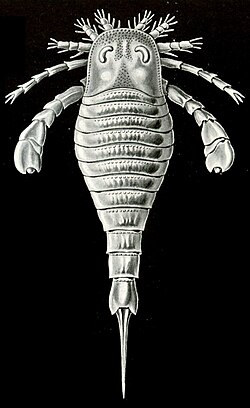Eurypterid
The eurypterids, related to arachnids, were the largest known arthropods. They are members of the extinct order Eurypterida. It is a most diverse Chelicerate order.[1] They are also called sea scorpions.
| Eurypterid Temporal range: Ordovician–Permian
| |
|---|---|

| |
| Eurypterid from Ernst Haeckel's Kunstformen der Natur (1904) | |
| Scientific classification | |
| Kingdom: | |
| Phylum: | |
| Class: | |
| Order: | † Eurypterida
|
The largest, such as Jaekelopterus, reached 2½ metres in length, but most species were less than 20 cm (8 inches). They were the largest arthropods of all time. They were predators which thrived in the warm, shallow seas and lakes of the Ordovician to the Permian periods, around 460 to 248 million years ago. Recent research suggsts their eyesight was not very good.[2]
The move from the sea to fresh water probably occurred by the Pennsylvanian period. Eurypterids went extinct during the Permian–Triassic extinction event 251 million years ago, and their fossils have a near global distribution.
Description
The typical eurypterid had a large, flat, semicircular carapace, followed by a jointed section, and finally a tapering, flexible tail, most ending with a long spine at the end (Pterygotus, though, had a large flat tail, possibly with a smaller spine). Behind the head of the eurypterids were twelve body segments. These segments are formed by a dorsal plate, called a tergite, and a ventral plate, called a sternite. The tail, known as the telson, is spiked in most eurypterids.[3]
A recent discovery of a new fossil species of eurypterid, Pentecopterus, has been made. It is two meters long, and lived 467 million years ago, in the Middle Ordovician period.[4][5]
Some genera
Gallery
Eurypterid Media
Restoration of Eurypterus with body parts labelled
Size comparison of six of the largest eurypterids: Pterygotus grandidentatus, Pentecopterus decorahensis, Acutiramus macrophthalmus, A. bohemicus, Carcinosoma punctatum, and Jaekelopterus rhenaniae
The holotype of Palmichnium kosinkiorum, containing the largest eurypterid footprints known
The supposed "gill tracts" of eurypterids have been compared to the air-breathing pseudotracheae present in the posterior legs of modern isopods, such as Oniscus (pictured).
Larval (left) and juvenile (right) instars of Strobilopterus (not to scale)
Pterygotus depicted hunting Birkenia
A reconstruction of Pentecopterus, the earliest known eurypterid. The family to which Pentecopterus belongs, the Megalograptidae, was the first truly successful eurypterid group.
Reconstruction of Erettopterus, a member of the highly successful Silurian and Devonian eurypterid family Pterygotidae
Reconstruction of Adelophthalmus, the only eurypterine (with swimming paddles) eurypterid to survive the Late Devonian extinction and persist into the subsequent Carboniferous and Permian periods.
References
- ↑ Dunlop, J.A.; et al. (2008). "How many species of fossil arachnids are there?". Journal of Arachnology. 36 (2): 267–272. doi:10.1636/CH07-89.1. ISSN 0161-8202. S2CID 42371883.
- ↑ Anderson R.P. et al 2014. What big eyes you have: the ecological role of giant pterygotid eurypterids. Biology Letters 10 (7): 20140412. [1]
- ↑ L. Størmer (1955). "Merostomata". Treatise on invertebrate paleontology, Part P Arthropoda 2, Chelicerata.
- ↑ BBC Radio 5 live. [2]
- ↑ Lamsdell, James C. et al 2015. The oldest described eurypterid: a giant Middle Ordovician (Darriwilian) megalograptid from the Winneshiek Lagerstätte of Iowa. BMC Evolutionary Biology 15: 169. [3]














